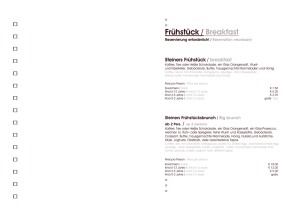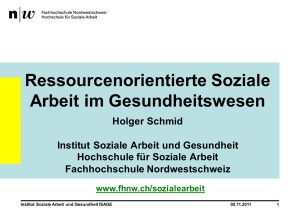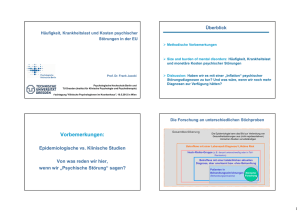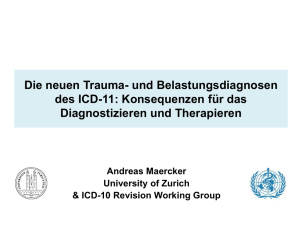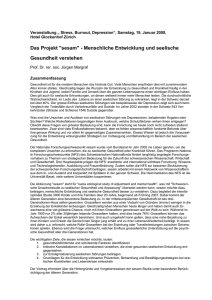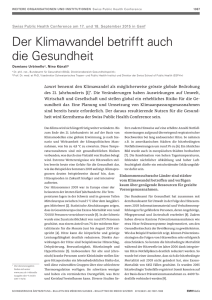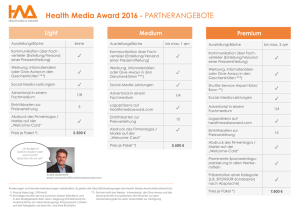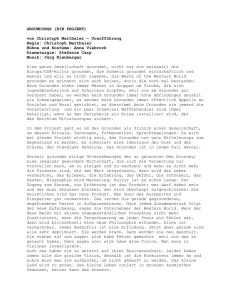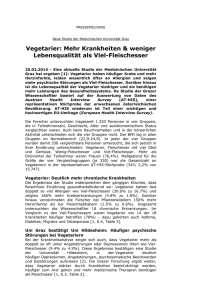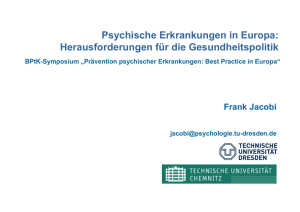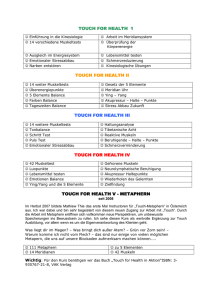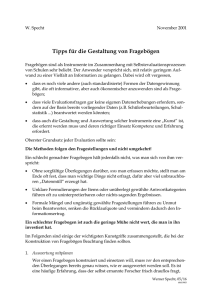Supplementary Material Title: The longitudinal BELLA study: Design
Werbung
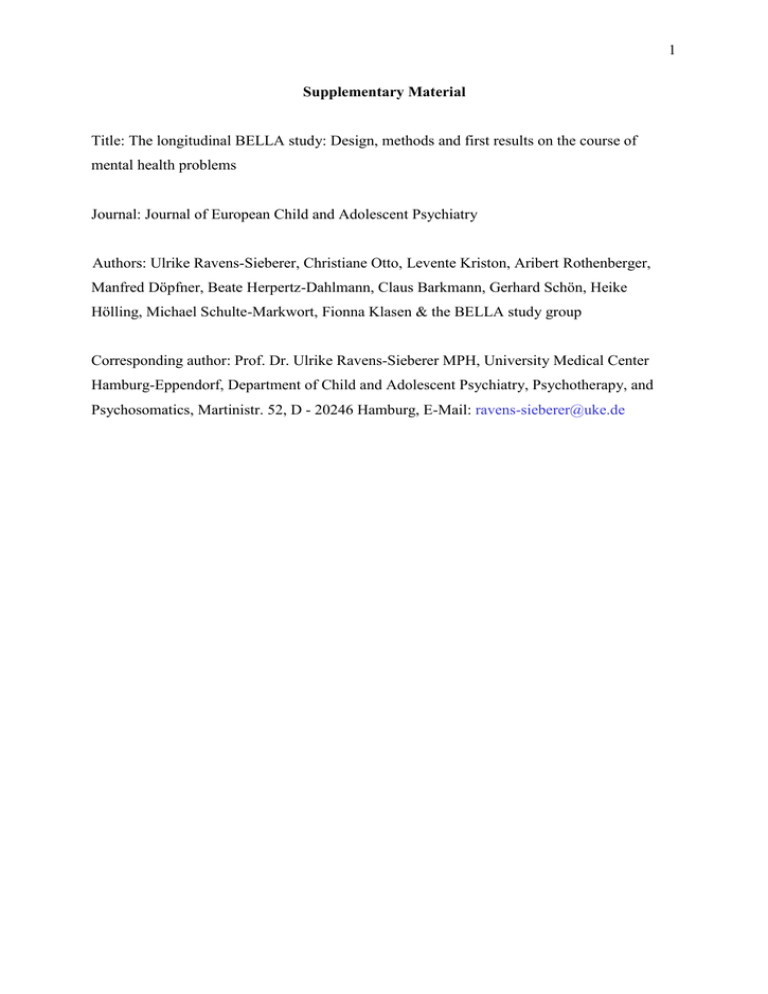
1 Supplementary Material Title: The longitudinal BELLA study: Design, methods and first results on the course of mental health problems Journal: Journal of European Child and Adolescent Psychiatry Authors: Ulrike Ravens-Sieberer, Christiane Otto, Levente Kriston, Aribert Rothenberger, Manfred Döpfner, Beate Herpertz-Dahlmann, Claus Barkmann, Gerhard Schön, Heike Hölling, Michael Schulte-Markwort, Fionna Klasen & the BELLA study group Corresponding author: Prof. Dr. Ulrike Ravens-Sieberer MPH, University Medical Center Hamburg-Eppendorf, Department of Child and Adolescent Psychiatry, Psychotherapy, and Psychosomatics, Martinistr. 52, D - 20246 Hamburg, E-Mail: [email protected] 2 Supplementary Table 1. Age of participants (baseline cohort and new participants) at each measurement point of the BELLA study BELLA baseline cohort Baseline (2002-2006) Age of participants 3 years old 4 years old 5 years old 6 years old 7 years old 8 years old 9 years old 10 years old 11 years old 12 years old 13 years old 14 years old 15 years old 16 years old 17 years old 18 years old 19 years old 20 years old 21 years old 22 years old 23 years old Total 268 283 287 291 265 252 261 221 266 243 226 2,863 1-year follow-up (2004-2007) 234 249 250 250 212 219 227 183 220 191 188 2,423 2-year follow-up (2005-2008) 206 231 240 225 181 207 208 167 192 158 175 2,190 New BELLA participants 6-year follow-up (2009-2012) 28 117 167 166 130 159 111 127 95 105 224 1,429 (2009-2012) 47 128 152 202 256 197 187 151 110 110 91 91 88 67 61 72 66 73 68 56 138 2,411 3 Supplementary Table 2. Measurements in the BELLA study 2-year follow-up 6-year follow-up 1-year follow-up Standardised measures/specific items Baseline Construct single item single item Winkler-Index1 Revised SES Index2 - - - SDQ SCARED PHQ-Screener Selected items of the FBB-ANG assessing Anxiety disorders (from the DISYPS-KJ) CES-DC DIKJ PHQ-8 Selected items of the FBB-DES assessing Depressive disorders (from the DISYPS-KJ) CBCL CRS-R FBB-HKS assessing Hyperkinetic disorders (from the DISYPS-KJ) Body weight in kilograms and height in meter for calculating the Body Mass Index (BMI) - - - - - - - - - - - - - - - - - - - KINDL-R KIDSCREEN SF-36 - - - SCL-S-9 SF-12 Items assessing the burden caused by housekeeping, being a single parent, tending a family member in need of care, job-related problems, or financial problems Items assessing family conflicts, harmony in partnership, unemployment, parental chronic diseases, unwanted pregnancy, parental alcohol consumption Items assessing serious illness or accident, death of a close person, marriage or new partnership, - - - Socio-demographic Variables Gender Age Socio-economic status Mental Health Problems General mental health problems Anxiety Depression Conduct Disorder ADHD Eating Disorders Mental Disorders SCOFF Confirmed diagnosis of mental health problems by physician. DIPS for Anxiety Disorders, Affective Disorders, Conduct Disorders, ADHD, Eating Disorders, Substance abuse/addiction. CID-S Health-related Quality of Life Risk factors Parental psychopathology Parental quality of life Parental strain Risk-Index Life events 4 change of school Protective factors Self-efficacy GSE Self-concept SPPC Selected items of the CHIP-AE ACOPE, ECOPE BFW, CSOS FCS 8 items from the HBSC Coping Optimism Family climate Parental support Social support Peer competence 8 selected age-appropriate items from the German SSS 5 items from the HBSC School climate 5 items from the HBSC Health care utilisation Items assessing use (and frequency of use) of health care utilisation by professionals, e.g. psychiatrist or psychologist Items assessing paths of mental health care utilisation Items assessing knowledge of mental health care provision Items assessing satisfaction with health care services Items assessing barriers towards mental health care utilisation 1 2 by Winkler & Stolzenberg [1]; by Lampert et al. [2] List of abbreviations: SES=socio-economic status (parental education, occupational qualification, occupational position, income) SDQ=Strength and Difficulties Questionnaire (Goodman [3]) & Impact Supplement (Goodman [4]) SCARED=Screen for child anxiety related emotional disorders (Birmaher et al. [5,6]; German version by Plass et al. [7]) PHQ-Screener=Patient Health Questionnaire-Screener for Panic Syndrom (Spitzer et al. [8]; German version by Löwe et al. [9]; Gräfe et al. [10]) FBB-ANG=Proxy-questionnaire for Anxiety disorders (Fremdbeurteilungsbogen für Angststörungen) from the Diagnostic System for Mental Disorders in Childhood and Adolescence (Diagnostik-System für psychische Störungen im Kindes- und Jugendalter; Döpfner et al. [11]) DISYPS-KJ=Diagnostic System for Mental Disorders in Childhood and Adolescence (Diagnostik-System für psychische Störungen im Kindes- und Jugendalter; Döpfner et al. [11]) CES-DC=Center for Epidemiological Studies Depression Scale for Children (Radloff et al. [12]; German version by Barkmann et al. [13]) DIKJ=Depression Inventory for Children and Adolescents (Depressions-Inventar für Kinder und Jugendliche; StiensmeierPelster et al. [14,15]) PHQ-8=Patient Health Questionnaire-8 (Kroenke et al. [16]; German version by Löwe et al. [9]; Gräfe et al. [10]) FBB-DES=Proxy-questionnaire for Depressive disorders (Fremdbeurteilungsbogen für Depressive Störungen) from the Diagnostic System for Mental Disorders in Childhood and Adolescence (Diagnostik-System für psychische Störungen im Kindes- und Jugendalter; Döpfner et al. [11]) CBCL=Child Behavior Checklist (Achenbach [17]; German version by Arbeitsgruppe Deutsche Child Behavior Checklist [18]) ADHD=Attention deficit hyperactivity disorder CRS-R=Conners‘ Rating Scales-Revised (Conners [19]; Conners et al. [20]) FBB-HKS=Proxy-questionnaire for Hyperkinetic disorders (Fremdbeurteilungsbogen für hyperkinetische Störungen) from the Diagnostic System for Mental Disorders in Childhood and Adolescence (Diagnostik-System für psychische Störungen im Kindes- und Jugendalter; Döpfner et al. [11]) SCOFF=SCOFF Questionnaire (Morgan et al. [21]; Hölling et al. [22]) DIPS=Diagnostic Interview for Mental Disorders in Children and Adolescents (Diagnostisches Interview bei psychischen Störungen im Kindes- und Jugendalter; Schneider et al. [23]; Unnewehr et al. [24]) CID-S=Composite International Diagnostic Screener (Wittchen et al. [25]) 5 KINDL-R=Questionnaire to assess Health-related Quality of Life in Children and Adolescents – Revised version (RavensSieberer et al. [26]) KIDSCREEN=Quality of Life Questionnaire for Children and Adolescents (Ravens-Sieberer et al. [27]) SF-36=Short Form-36 Health Survey (Ware et al. [28]; German version by Bullinger et al. [29]) SCL-S-9=Symptom-Check List Shortversion-9 (Klaghofer et al. [30]) SF-12= Short Form-12 Health survey (Ware et al. [31]; German version by Bullinger et al. [29]) GSE=General Self-Efficacy Scale (Schwarzer et al. [32]; German version by Schwarzer et al. [33]) SPPC=Self-Perception Profile for Children (Harter [34]; German version by Asendorpf et al. [35]) CHIP-AE=Child Health and Illness Profile-Adolescent Edition (Starfield et al. [36]) ACOPE=Problem-focused Coping (Problemorientiertes, aktives Coping; Jerusalem et al. [37]) ECOPE=Emotion-focused Coping (Emotionsorientiertes, vermeidendes Coping; Bäßler et al. [38]) BFW=Berner Questionnaire on Adolescents’ Subjective Well-Being (Berner Fragebogen für Wohlbefinden; Grob et al. [39]) CSOS=Children’s Sense of Coherence Scale (Margalit et al. [40]; German version by Kern et al. [41]) FCS=Family Climate Scale (Familienklima-Skala; Schneewind et al. [42]) which is the German adaptation of the Family Environmental Scale (Moos [43]; Moos et al. [44]) HBSC=Health Behaviour in School-aged Children survey (Currie et al. [45]) SSS=Social Support Scale (Donald et al. [46]) 6 Supplementary References 1. Winkler J, Stolzenberg H (1999) [Social class index in the Federal Health Survey]. Gesundheitswesen 61 Spec No:S178-183 2. Lampert T, Kroll L, Muters S, Stolzenberg H (2013) Messung des soziookonomischen Status in der Studie zur Gesundheit Erwachsener in Deutschland (DEGS1) (Measurement of socioeconomic status in the German Health Interview and Examination Survey for Adults (DEGS1)). Bundesgesundheitsblatt Gesundheitsforschung Gesundheitsschutz 56 (5-6):631636. doi:10.1007/s00103-012-1663-4 3. Goodman R (1997) The Strengths and Difficulties Questionnaire: a research note. J Child Psychol Psychiatry 38 (5):581-586 4. Goodman R (1999) The extended version of the strengths and difficulties questionnaire as a guide to child psychiatric caseness and consequent burden. J Child Psychol Psychiatry 40 (5):791-799. doi:10.1017/S0021963099004096 5. Birmaher B, Khetarpal S, Brent D, Cully M, Balach L, Kaufman J, Neer SM (1997) The Screen for Child Anxiety Related Emotional Disorders (SCARED): scale construction and psychometric characteristics. J Am Acad Child Adolesc Psychiatry 36 (4):545-553. doi:10.1097/00004583-199704000-00018 6. Birmaher B, Brent DA, Chiappetta L, Bridge J, Monga S, Baugher M (1999) Psychometric properties of the Screen for Child Anxiety Related Emotional Disorders (SCARED): a replication study. J Am Acad Child Adolesc Psychiatry 38 (10):1230-1236. doi:10.1097/00004583-199910000-00011 7. Plass A, Barkmann C, Mack B, Mittenzwei K, Riedesser P, Schulte-Markwort M (2004) German translation and validation of the Screen for Child Anxiety Related Emotional Disorders (SCARED) - first results. Book of abstracts of the 16th World Congress of the International Association for Child and Adolescent Psychiatry and Allied Professions (IACAPAP) in Berlin, 22.-26. August 2004. Steinkopff, Darmstadt 8. Spitzer RL, Williams JB, Kroenke K (2013) Instruction Manual. Instructions for Patient Health Questionnaire (PHQ) and GAD-7 Measures. http://www.phqscreeners.com/instructions/instructions.pdf. Accessed 31 March 2014 9. Löwe B, Spitzer RL, Zipfel S, Herzog W (2002) PHQ-D: Gesundheitsfragebogen für Patienten. Manual Komplettversion und Kurzform. http://www.klinikum.uniheidelberg.de/fileadmin/Psychosomatische_Klinik/download/PHQ_Manual1.pdf. Accessed 20 March 2014 10. Gräfe K, Zipfel S, Herzog W, Löwe B (2004) Screening psychischer Störungen mit dem 7 “Gesundheitsfragebogen für Patienten (PHQ-D)“. Diagnostica 50 (4):171-181. doi:10.1026/0012-1924.50.4.171 11. Döpfner M, Lehmkuhl G (2000) Diagnostik- System für Psychische Störungen im Kindes- und Jugendalter nach ICD-10 und DSM-IV (DISYPS-KJ), 2 edn. Huber, Bern 12. Radloff LS (1977) The CES-D scale: a self-report depression scale for research in the general population. Applied Psychological Measurement 1 (3):385-401. doi:10.1177/014662167700100306 13. Barkmann C, Erhart M, Schulte-Markwort M, Bella Study Group (2008) The German version of the Centre for Epidemiological Studies Depression Scale for Children: psychometric evaluation in a population-based survey of 7 to 17 years old children and adolescents - results of the BELLA study. Eur Child Adolesc Psychiatry 17 (Suppl. 1):116124. doi:10.1007/s00787-008-1013-0 14. Stiensmeier-Pelster J, Schürmann M, Duda K (2000) DIKJ - Depressions-Inventar für Kinder und Jugendliche, 2nd edn. Hogrefe, Göttingen 15. Stiensmeier-Pelster J, Schürmann M, Duda K (1989) Depressions-Inventar für Kinder und Jugendliche (DIKJ). Hogrefe, Göttingen 16. Kroenke K, Spitzer RL (2002) The PHQ-9: A new depression diagnostic and severity measure. Psychiatr Ann 32 (9):509-515 17. Achenbach TM (1991) Manual for the Child Behavior Checklist/4–18 and 1991 Profile. University of Vermont, Department of Psychiatry, Burlington, VT 18. Arbeitsgruppe Deutsche Child Behavior Checklist (1998) Elternfragebogen über das Verhalten von Kindern und Jugendlichen; deutsche Bearbeitung der Child Behavior Checklist (CBCL/4-18). Einführung und Anleitung zur Handauswertung, 2. Auflage mit deutschen Normen. Arbeitsgruppe Kinder-, Jugend- und Familiendiagnostik, 2nd edn. Hogrefe, Köln 19. Conners CK (1997) Conners’ rating scale – revised (CRS-R): technical manual. MultiHealth Systems Inc, North Tonawanda, NY 20. Conners CK, Sitarenios G, Parker JD, Epstein JN (1998) The revised Conners' Parent Rating Scale (CPRS-R): factor structure, reliability, and criterion validity. J Abnorm Child Psychol 26 (4):257-268 21. Morgan JF, Reid F, Lacey JH (1999) The SCOFF questionnaire: assessment of a new screening tool for eating disorders. BMJ 319 (7223):1467-1468 22. Holling H, Schlack R (2007) [Eating disorders in children and adolescents. First results of the German Health Interview and Examination Survey for Children and Adolescents (KiGGS)]. Bundesgesundheitsblatt Gesundheitsforschung Gesundheitsschutz 50 (5-6):794- 8 799. doi:10.1007/s00103-007-0242-6 23. Schneider S, Margraf J (eds) (2011) Diagnostisches Interview bei psychischen Störungen. 4th edn. Springer, Heidelberg 24. Unnewehr S, Schneider S, Margraf J (2009) Diagnostisches Interview bei psychischen Störungen im Kindes- und Jugendalter (Kinder-DIPS), 2nd edn. Springer, Heidelberg 25. Wittchen HU, Höfler M, Gander F, Pfister H, Storz S, Üstün B, Müller N et al. (1999) Screening for mental disorders: performance of the Composite International Diagnostic – Screener (CID–S). Int J Methods Psychiatr Res 8 (2):59-70. doi:10.1002/mpr.57 26. Ravens-Sieberer U, Bullinger M (1998) Assessing health-related quality of life in chronically ill children with the German KINDL: first psychometric and content analytical results. Qual Life Res 7 (5):399-407 27. Ravens-Sieberer U, the European KIDSCREEN Group (2006) The KIDSCREEN Questionnaires - Quality of life questionnaires for children and adolescents – Handbook. Pabst Science Publisher, Lengerich 28. Ware JE, Sherbourne CD (1992) The MOS 36-item short-form health survey (SF-36). I. Conceptual framework and item selection. Med Care 30 (6):473-483. doi:10.1097/00005650199206000-00002 29. Bullinger M, Kirchberger I (1998) SF-36 Fragebogen zum Gesundheitszustand Handanweisung. Hogrefe, Göttingen 30. Klaghofer R, Braehler E (2001) Konstruktion und teststatistische Prüfung einer Kurzform der SCL-90-R (Construction and validation of a short form of the SCL-90-R). Z Klin Psychol Psychiatr Psychother 49 (2):115-124 31. Ware J, Kosinski M, Keller SD (1996) A 12-Item Short-Form Health Survey: construction of scales and preliminary tests of reliability and validity. Med Care 34 (3):220-233 32. Schwarzer R, Jerusalem M (1995) Generalized self-efficacy scale. In: Weinman J, Wright S, Johnston M (eds) Measures in health psychology: A user’s portfolio. Causal and control beliefs. NFER-NELSON, Windsor, UK, pp 35-37 33. Schwarzer R, Jerusalem M (1999) Skalen zur Erfassung von Lehrer- und Schülermerkmalen. Dokumentation der psychometrischen Verfahren im Rahmen der wissenschaftlichen Begleitung des Modellversuchs Selbstwirksame Schulen. Freie Universität Berlin, Institut für Psychologie. http://www.psyc.de/skalendoku.pdf. Accessed 20 March 2014 34. Harter S (1985) Manual for the Self-Perception Profile for Children (Technical Report). University of Denver, Denver, CO 35. Asendorpf JB, von Aken MAG (1993) Self-Perception Profile for Children - deutsche 9 Fassung (SPPC-D). Humboldt-Universität, Institut für Psychologie. http://www.zpid.de/pub/tests/pt_2599t.pdf. Accessed 20 March 2014 36. Starfield B, Riley AW, Green BF, Ensminger ME, Forrest CB, Robertson J, Ryan S et al. (2000) Manual for the Child Health and Illness Profile-Adolescent Edition (CHIP-AE). The Johns Hopkins University, Baltimore, MD 37. Jerusalem M, Mittag W (1999) Problemorientiertes, aktives Coping (ACOPE). In: Schwarzer R, Jerusalem M (eds) Skalen zur Erfassung von Lehrer- und Schülermerkmalen. Dokumentation der psychometrischen Verfahren im Rahmen der Wissenschaftlichen Begleitung des Modellversuchs Selbstwirksame Schulen. Freie Universität Berlin, Institut für Psychologie, Berlin, pp 26-27 38. Bäßler J, Schwarzer R (1999) Emotionsorientiertes, vermeidendes Coping (ECOPE). In: Schwarzer R, Jerusalem M (eds) Skalen zur Erfassung von Lehrer- und Schülermerkmalen. Dokumentation der psychometrischen Verfahren im Rahmen der Wissenschaftlichen Begleitung des Modellversuchs Selbstwirksame Schulen. Freie Universität Berlin, Institut für Psychologie, Berlin, pp 27-28 39. Grob A, Lüthi R, Kaiser FG, Flammer A, Mackinnon A, Wearing AJ (1991) Berner Fragebogen zum Wohlbefinden Jugendlicher (BFW) (The Bern Subjective Well-Being Questionnaire for Adolescents (BFW)). Diagnostica 37:66-75 40. Margalit M, Efrati M (1996) Loneliness, Coherence and Companionship among Children with Learning Disorders. Educational Psychology 16 (1):69-79. doi:10.1080/0144341960160106 41. Kern R, Rasky E, Noack RH (1995) Indikatoren für Gesundheitsförderung in der Volksschule. Forschungsbericht 95/1. Karl-Franzens-Universität, Graz 42. Schneewind K, Beckmann M, Hecht-Jackl A (1985) Familienklima-Skalen. Bericht 8.1 und 8.2. Ludwig Maximilians Universität, Institut für PsychologiePersönlichkeitspsychologie und Psychodiagnostik. 43. Moos RH (1974) Family Environment Scale. Consulting Psychologists Press, Palo Alto, CA 44. Moos RH, Moos BS (2009) Family environment scale manual and sampler set: development, applications and research, 4th edn. Mind Garden Inc, Palo Alto, CA 45. Currie C, Griebler R, Inchley J, Theunissen A, Molcho M, Samdal O, Dür W (2010) Health Behaviour in School-aged Children (HBSC) study protocol: background, methodology and mandatory items for the 2009/10 survey. CAHRU & LBIHPR. http://www.hbsc.org/methods/index.html. Accessed 31 March 2014 10 46. Donald CA, Ware JE (1984) The measurement of social support. Res Community Ment Health 4:325–370
